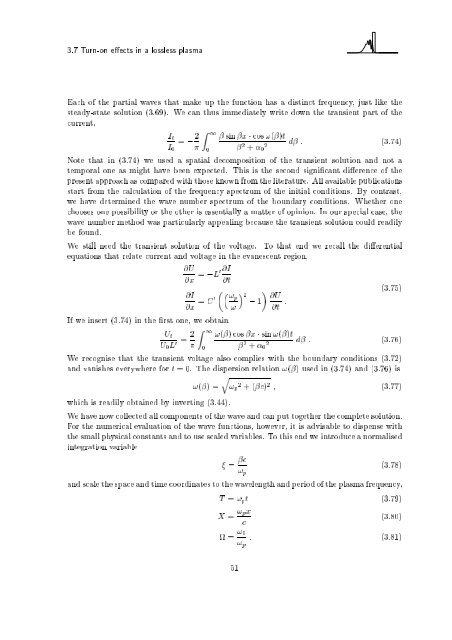Wave Propagation in Linear Media | re-examined
Wave Propagation in Linear Media | re-examined
Wave Propagation in Linear Media | re-examined
Create successful ePaper yourself
Turn your PDF publications into a flip-book with our unique Google optimized e-Paper software.
3.7 Turn-on e ects <strong>in</strong> a lossless plasma<br />
Each of the partial waves that make up the function has a dist<strong>in</strong>ct f<strong>re</strong>quency, just like the<br />
steady-state solution (3.69). We can thus immediately write down the transient part of the<br />
cur<strong>re</strong>nt,<br />
It<br />
= , 2 Z 1<br />
s<strong>in</strong> x cos !( )t<br />
d : (3.74)<br />
I0<br />
0<br />
2 + 0 2<br />
Note that <strong>in</strong> (3.74) we used a spatial decomposition of the transient solution and not a<br />
temporal one as might have been expected. This is the second signi cant di e<strong>re</strong>nce of the<br />
p<strong>re</strong>sent approach as compa<strong>re</strong>d with those known from the literatu<strong>re</strong>. All available publications<br />
start from the calculation of the f<strong>re</strong>quency spectrum of the <strong>in</strong>itial conditions. By contrast,<br />
we have determ<strong>in</strong>ed the wave number spectrum of the boundary conditions. Whether one<br />
chooses one possibility or the other is essentially a matter of op<strong>in</strong>ion. In our special case, the<br />
wave number method was particularly appeal<strong>in</strong>g because the transient solution could <strong>re</strong>adily<br />
be found.<br />
We still need the transient solution of the voltage. To that end we <strong>re</strong>call the di e<strong>re</strong>ntial<br />
equations that <strong>re</strong>late cur<strong>re</strong>nt and voltage <strong>in</strong> the evanescent <strong>re</strong>gion,<br />
@U<br />
@x<br />
= ,L0@I<br />
@t<br />
@I !p<br />
= C0<br />
@x<br />
If we <strong>in</strong>sert (3.74) <strong>in</strong> the rst one, we obta<strong>in</strong><br />
Ut<br />
U0L0 = 2 Z 1<br />
0<br />
!<br />
2<br />
, 1 @U<br />
@t :<br />
(3.75)<br />
!( ) cos x s<strong>in</strong> !( )t<br />
d : (3.76)<br />
2 + 0 2<br />
We <strong>re</strong>cognise that the transient voltage also complies with the boundary conditions (3.72)<br />
and vanishes everywhe<strong>re</strong> for t =0. The dispersion <strong>re</strong>lation !( ) used <strong>in</strong> (3.74) and (3.76) is<br />
q<br />
!( )= !p 2 +( c) 2 ; (3.77)<br />
which is <strong>re</strong>adily obta<strong>in</strong>ed by <strong>in</strong>vert<strong>in</strong>g (3.44).<br />
We havenow collected all components of the wave and can put together the complete solution.<br />
For the numerical evaluation of the wave functions, however, it is advisable to dispense with<br />
the small physical constants and to use scaled variables. To this end we <strong>in</strong>troduce a normalised<br />
<strong>in</strong>tegration variable<br />
= c<br />
!p<br />
(3.78)<br />
and scale the space and time coord<strong>in</strong>ates to the wavelength and period of the plasma f<strong>re</strong>quency,<br />
T = !pt (3.79)<br />
X = !px<br />
c<br />
= !0<br />
!p<br />
51<br />
(3.80)<br />
: (3.81)












